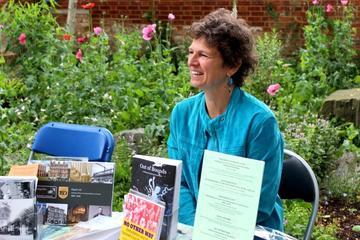Top tips for embarking on a Community History Project
In this blog post, Liz Woolley (freelance local historian) shares her rich expertise and experiences in pursuing community history research: including offering her top tips for anyone thinking of embarking on a project themselves.

Liz Woolley at the Jericho Book Fair, 27 June 2021
Are you curious to know why your road is called after a distant town or a long-forgotten politician? Have you ever wondered why the church is at one end of your village, rather than in the middle, or what was on the corner of your street before that ugly 1970s block of flats was built? Are you investigating your family history and would like to know more about where your ancestors lived and the community they were part of? How it was affected by the coming of a canal or railway, or what happened to it during the War? These are all questions which the growing number of people engaged in researching the history of their local area – be it a city, town, village, parish, suburb, street, or even a single building – are asking, and enjoying finding the answers to.
To my mind, local history is about three things: people, buildings, and landscape, and how they have interacted with each other to make a locality what it is today.
I’ve been lucky enough to be a freelance local historian for the last ten years, making a living [just about] doing the thing I love. This means a very wide variety and a mixed bag of activities. I carry out research for clients – heritage groups, museums, businesses, public sector bodies, individuals – on buildings and areas of Oxford and Oxfordshire. I do lots of illustrated talks and guided walks (usually about a hundred a year), and I design touring exhibitions and put up history information boards aimed at helping both locals and visitors to find out more about the history of an area and about the people who have lived there. I manage the South Oxford History website and I write articles and books, podcasts, blog posts and the occasional short film. And probably best of all, I organise community history projects: almost always the most work, but also the most rewarding!
I find that local history research lends itself really well to working on a group project, with family, friends, colleagues or neighbours. It’s a great way to get together with other people – both in person and on-line – and to share information and learn new skills. A good example was 66 Men of Grandpont 1914-18, a community history project in South Oxford which ran from 2015 to 2017 and ended up involving hundreds of local people, as well as many more from further afield. It started off with a fairly simple idea – to research the lives of the 66 men named on our local First World War memorial – but grew to include an extensive on-line archive containing a wealth of previously unpublished material, a touring exhibition, a poppy trail around the local streets, an award-winning documentary film and dozens of events at which the results of the project were shared with the public and with schools. All the historical research was done by local volunteers. We made contact with the relatives of more than 20 of the 66 men, some of whom didn’t even know of the existence of their ancestor and the part he’d played in the War, but all of whom were enthusiastic, and generous with their time and with family archives, which really enriched the project.
The poppy trail was probably the thing which sparked the most interest and commendation. We identified all the houses in which the 66 men had lived before they went off to war and, with the current owners’ permission, but a laminated biography of each man and a large poppy on the front gate, wall or window. We produced a map and put a copy through every door in the area, and to our surprise, hundreds – perhaps even thousands – of adults and children followed the trail, and many contacted us to say how thought-provoking and moving they had found it. As one said “Just wandering down Western Road and seeing the number of signs outside the former homes really brought it home as to what utter devastation that war brought to just one small area.”
For me that really sums up the success of the 66 Men of Grandpont project, and indeed the power of local history projects in general. The best local history, I think, helps people to connect to their area, to be proud of its unique heritage, and to feel themselves as part of a community which has a past, a present and a future. And, importantly, it also sets that local story in a wider context, helping to illuminate national – or even international – history, by revealing the real experiences of ordinary people on the ground.
I’ve been lucky enough to be involved in several community history projects like this in the last few years, and to have found organisations – the City Council, some Oxford colleges, Oxford University and some local charities and businesses – willing to sponsor them. My advice to anyone planning to do the same would be, first and foremost, to involve as many people and local organisations as you can, because connecting people – to each other, to their communities and to their surroundings – is what it’s all about.
- Liz Woolley


